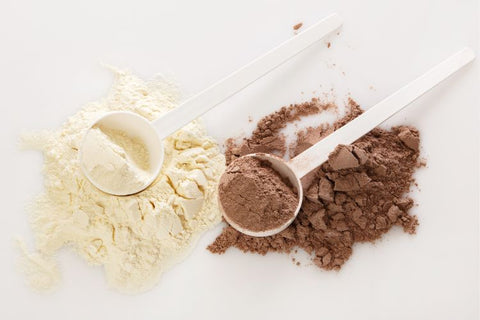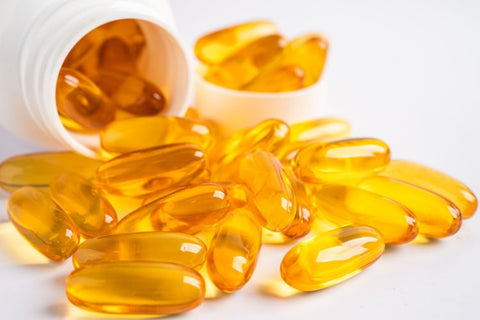Protein powder is a popular supplement used by athletes and fitness enthusiasts alike. But with all the varieties and brands available, one question often arises: Does protein powder expire? The answer might surprise you. Let's delve into the world of protein powder shelf life and explore what that expiration date truly means.
Understanding Expiration Dates
The expiration date on protein powders typically indicates the manufacturer's estimated timeframe for the product to maintain optimal quality. It does not necessarily signify a safety hazard. Here's why considering it is important:
- Freshness and Potency: The date suggests when the protein powder will likely retain its original taste, texture, and nutrient content.
- Manufacturer's Recommendation: It reflects the manufacturer's assessment of how long the product stays at its best under proper storage conditions.
- Ensuring Optimal Benefits: Consuming protein powder within the timeframe helps ensure you're getting the intended nutritional value and desired taste.
- Minimizing Potential Risks: While generally safe past the date, consuming expired protein powder with significant changes in smell, taste, or texture might lead to mild stomach discomfort like gas or bloating.
Remember, the expiration date is a guideline, and proper storage plays a crucial role in maintaining quality. If your protein powder is past the date but appears and smells normal, it might still be safe to consume.
Impact of Storage Conditions
Storage conditions significantly impact protein powder's lifespan and quality. Moisture causes clumping and fosters bacteria growth, so keep it dry. Heat breaks down protein and reduces its benefits, so store it cool and dark. Light can degrade nutrients, making opaque containers or dark spaces ideal. Oxygen accelerates fat rancidity, so use airtight containers. Cleanliness and proper sealing prevent contamination.
Here is why maintaining proper storage is crucial for several reasons:
- Preserves nutrients: Ensures you get the full protein content and other valuable nutrients.
- Prevents spoilage: Minimizes exposure to harmful elements, extending shelf life.
- Ensures safety: Promotes a clean and sanitary environment, preventing contamination.
- Saves money: Avoids replacing spoiled protein powder, saving you money in the long run.
Consequences of Protein Content Degradation
Protein content degradation refers to the breakdown of protein molecules in protein powder over time.
It is important to note that degradation in protein powder over time can have several potential consequences:
Reduced Nutritional Value: The primary concern is the loss of protein content itself. This means you're not getting the intended dosage of protein you expect from the product. Additionally, degradation can affect the levels of other essential nutrients like amino acids, potentially compromising the overall nutritional profile.
Altered Functionality: Protein molecules have specific structures crucial for their functions. Degradation can alter these structures, reducing their effectiveness in supporting muscle growth, repair, and other physiological processes.
Unpleasant Taste and Texture: Protein breakdown can lead to the formation of off-flavors and unpleasant odors. Additionally, the consistency of the powder might change, becoming clumpy or grainy instead of smooth and easily mixable.
Potential Health Risks: While rare, consuming highly degraded protein powder with significant bacterial growth might lead to stomach discomfort, bloating, or even foodborne illness in individuals with sensitive digestive systems.
Consumers should be mindful of these potential consequences for several reasons:
- To ensure they receive the intended benefits: By being mindful of storage and expiration dates, consumers can maximize the effectiveness and value they get from their protein powder.
- To avoid potential health risks: While uncommon, proper storage minimizes the risk of consuming spoiled protein powder that could lead to digestive issues.
- To get the most out of their investment: Proper storage practices extend the shelf life of protein powder, preventing unnecessary waste and saving money in the long run.
By understanding these potential consequences, consumers can make informed choices regarding the storage and consumption of protein powder.
Identifying Expired Protein Powder
While the expiration date provides a general guideline, consumers can rely on sensory cues like odor and taste to identify potentially expired protein powder. Here's how these senses play a role:
Odor:
- Fresh protein powder: Should have a neutral or slightly sweet aroma.
- Expired protein powder: May develop an unpleasant, rancid, or off-putting odor, indicating potential degradation.
Taste:
- Fresh protein powder: This should have a pleasant or neutral taste depending on the flavoring.
- Expired protein powder: May develop a bitter, sour, or off-taste, signifying potential degradation.
Significance of Sensory Changes:
- Early Warning Signs: Changes in odor and taste are often some of the first and most noticeable signs of protein powder degradation.
- Quality Indicator: These changes often indicate a decline in the overall quality of the protein powder, even if it hasn't technically "expired" according to the date.
- Consumer Safety: In extreme cases, significant changes in odor and taste might suggest spoilage or bacterial growth, making the powder unsafe for consumption.
Therefore, if you notice unpleasant changes in odor or taste, it's best to discard the protein powder and purchase a fresh one. While these changes don't guarantee the powder is unsafe, they serve as reliable indicators of potential quality decline and a nudge to prioritize freshness for optimal benefits and safety.
Texture Changes as Indicators
While the expiration date serves as a guide, texture can also reveal a protein powder's quality. Fresh powder should be smooth and flow easily. Clumps, grittiness, or hardness often indicate expiration, making it difficult to mix and potentially affecting its usability and even its effectiveness in the body.
If your protein powder feels off, it's best to play it safe and replace it for optimal experience and benefits.
Safety Concerns with Microbial Growth
Microbial growth refers to the reproduction and increase in the number of microorganisms like bacteria, mold, or yeast. When conditions are favorable, such as in the presence of moisture, warmth, and nutrients, these microbes can multiply rapidly within a short period. Protein powder, especially if exposed to moisture, can become a breeding ground for some of these microbes.
Below are some safety concerns with expired protein powder
- Foodborne Illness: Consuming protein powder contaminated with harmful bacteria can lead to food poisoning, causing symptoms like nausea, vomiting, diarrhea, and stomach cramps.
- Increased Risk for Vulnerable Groups: People with weakened immune systems (elderly, children, those with medical conditions) are more susceptible to complications from foodborne illnesses.
- Hidden Growth: Early stages of microbial growth might not be visible or detectable by smell, making consumption of contaminated powder more likely.
How Consumers Can Mitigate Risk
- Proper Storage: Keep protein powder in a cool, dry, dark place to reduce the chance of microbial growth.
- Respect Expiration Dates: While not foolproof, dates provide guidance. It's best to discard expired powder.
- Inspect for Changes: Discard powder with noticeable changes in smell, taste, or texture, as these often indicate spoilage.
- Good Hygiene: Use clean equipment when handling protein powder to prevent accidental contamination.
Degradation of Added Vitamins and Minerals in Protein Powder
While the protein content in protein powder is the main focus, many brands also add essential vitamins and minerals to their formulas. However, these added nutrients can degrade over time, impacting the overall nutritional value of the powder.
Several factors contribute to the breakdown of vitamins and minerals:
- Exposure to heat and light: Similar to how sunlight fades colors, heat and light can break down the chemical structure of vitamins, particularly those sensitive to light, like vitamins A and C.
- Moisture: When exposed to moisture, vitamins and minerals can undergo hydrolysis, a process that alters their structure and reduces their bioavailability, making them less usable by the body.
- Oxidation: This reaction with oxygen can degrade certain vitamins like vitamin E and some minerals, diminishing their effectiveness.
The degradation of added vitamins and minerals also directly affects the overall nutritional value of protein powder:
- Reduced Potency: Degraded vitamins and minerals become less potent, meaning they provide fewer of their intended health benefits.
- Incomplete Nutritional Profile: If several vitamins and minerals degrade significantly, the powder may no longer offer the comprehensive profile it originally did.
While the protein content might not degrade significantly, the potential loss of added vitamins and minerals over time underscores the importance of proper storage and consuming protein powder within a reasonable timeframe.
Role of Color Changes
While color changes are not always a reliable indicator, drastic alterations in the color of the protein powder may suggest chemical reactions or degradation, signaling that it is no longer safe for consumption. Note, though, that they should not be solely relied upon for definitive assessment. Here's the breakdown:
- Fresh protein powder: Should have a consistent color based on its flavor and ingredients. For example, natural whey protein is typically light yellow or beige, while chocolate-flavored variants may be brown.
- Potential Signs of Degradation: Significant darkening, browning, or discoloration from the original shade might suggest protein degradation or the breakdown of added ingredients like artificial coloring.
Limitations of Color Cues:
- Natural Variations: Some protein powders, especially those with natural ingredients, may exhibit slight variations in color between batches, which doesn't necessarily indicate spoilage.
- Flavoring Impact: Different flavors may have inherent color variations, making it challenging to establish a universal "fresh" color across all protein powders.
- Degradation Without Color Change: In some cases, protein powder might degrade without significant color changes, especially in the early stages.
How Consumers Can Leverage Color:
- Compare to Baseline: While not foolproof, consumers can compare the color of their protein powder to its original appearance when first purchased. Any significant deviations might warrant further investigation.
- Consider in Conjunction with Other Cues: Color changes shouldn't be the sole indicator. Combine this observation with smell, taste, and texture for a more comprehensive assessment.
- When in Doubt, Discard: If you're unsure about the color change or have other concerns, it's best to err on the side of caution and discard the protein powder and purchase a fresh one.
Ensuring Packaging Integrity
One crucial step, often overlooked, is inspecting the packaging for any damage. But why exactly is this important?
Inspecting the packaging of protein powder for damage is crucial for two key reasons: ensuring product safety and maintaining product quality.
Key Takeaways
- Expiration Dates: They indicate optimal quality, not necessarily safety. Proper storage is crucial for maintaining freshness and potency.
- Storage Conditions: Moisture, heat, light, and oxygen affect protein powder's shelf life. Clean, dry, dark, and airtight storage preserves nutrients and prevents spoilage.
- Consequences of Degradation: Reduced nutritional value, altered functionality, unpleasant taste/texture, and potential health risks highlight the importance of proper storage and timely consumption.
- Identifying Spoilage: Sensory cues like odor, taste, and texture changes can indicate protein powder degradation. Safety concerns arise from microbial growth and nutrient degradation.
- Packaging Integrity: Damaged packaging can compromise safety and quality. Prioritize safety by discarding expired or suspicious protein powder.





